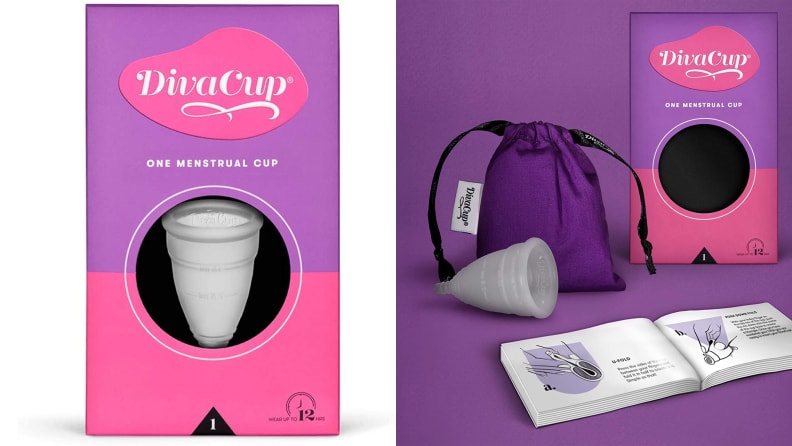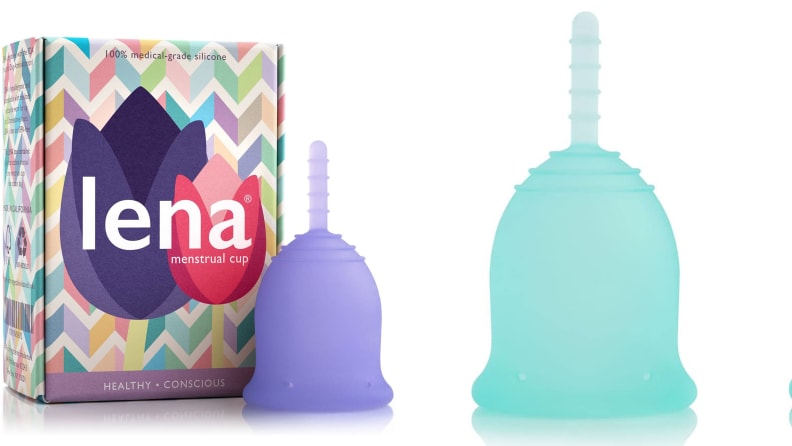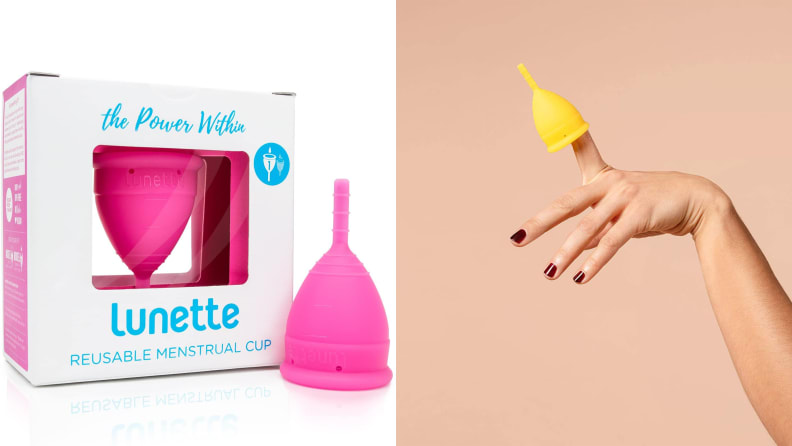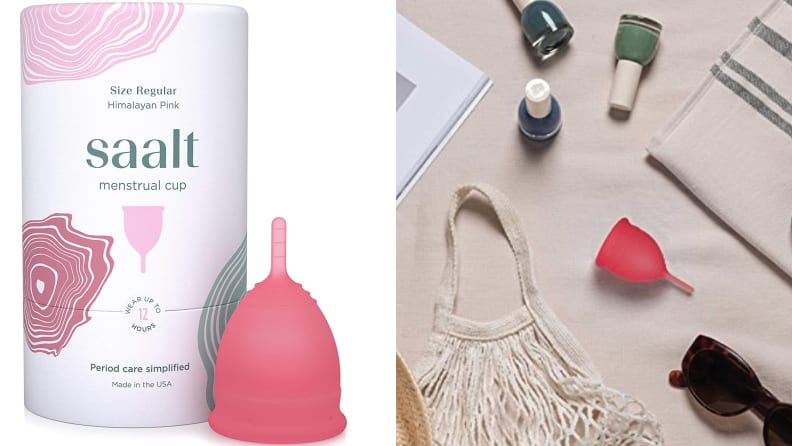Are menstrual cups right for you? Here's what you need to know
The pros and cons of this reusable period product
Products are chosen independently by our editors. Purchases made through our links may earn us a commission.
Good news: If you are a person who has a period, you have a lot of options for when you are on your period. You can use conventional tampons and pads, organic tampons and pads, period underwear, and menstrual cups.
Bad news: If you are a person who has a period, you have a lot of options—so many that it can be difficult to decide which one to actually use, especially as recent shortages of essential supplies have made headlines.
At Reviewed, we have covered organic tampons and period underwear, but what of menstrual cups? If you're thinking of trying one, here’s what you should consider, according to a gynecologist.
What is a menstrual cup?
A menstrual cup is a small, flexible cup, usually made of silicone, that is inserted into the vagina during one’s period. The biggest difference between a menstrual cup and a tampon, pad, or period underwear is that the cup collects menstrual fluid, rather than absorbing it. This requires the wearer to remove, empty, and clean it for reuse.
They aren’t exactly new—one model dates back to the 1860s, according to Popular Science—but they have been re-popularized in recent years by brands like DivaCup, Lena, Saalt, and Lunette.
What are the benefits of menstrual cups?
Most menstrual cups are reusable, so they produce far less waste than conventional period products. This also means that it’s less costly to use menstrual cups. One menstrual cup is more expensive than a box of tampons (a box of 50 Tampax Pearls costs around $9 on Amazon and one Diva Cup is $23.95 on Amazon)—but a single menstrual cup can last a few years, and tampon boxes have to be replenished. Technically, only one cup is needed for the duration of a period, though many users keep two or three in rotation. There is no clear consensus on menstrual cup lifespan, but most brands recommend replacing it when it starts getting discolored, develops holes, or is in visibly bad condition.
Another benefit is that menstrual cups can be left in for up to 12 hours, meaning you could wear one all day long without having to deal with it until you get home (though some people with heavy flows may need to take them out more frequently). This is much longer than tampons, which should be changed every four to eight hours, according to the FDA. Using a cup is also likely to be more comfortable than wearing pads and period underwear, neither of which have a safety limit on how long they can be worn but can feel bulky and get uncomfortably soggy after a few hours. “Sometimes the pads can get irritating by constant friction against the vulva so women may prefer cups,” says Dr. Adeeti Gupta, founder of Walk In Gyn Care in New York City.
Another potential positive: There’s less likelihood of odor with menstrual cups than with pads and tampons, according to the Cleveland Clinic. This is because menstrual blood has bacteria in it that, when exposed to air, can develop a pungent scent. But because menstrual cups keep the contents sealed away from the air until emptied, the chances of an unpleasant smell are much lower.
What are the downsides of menstrual cups?
The designs of menstrual cups vary from brand to brand, but each one requires folding it in some way to insert it and pulling on a stem or loop to extract it. In short, every cup requires the user to reach into their vagina while menstruating—somewhat like using an applicator-free tampon—which may squick some people out, and has a bit of a learning curve. Some users also say menstrual cups can be difficult to remove, especially because the cup can create a suctioning effect when it comes out. People get used to this over time, but it’s an understandably weird feeling the first few times. As one DivaCup reviewer put it: “1. You must be comfortable touching yourself. 2. You must be comfortable getting a bit messy. 3. Have a sink nearby.”
The nearby sink is essential because you also have to empty and rinse out the cup between uses, which could be problematic in public restrooms. “If you are traveling, or work in places where you don't have access to reasonably private toilets, it may be hard to wash the cups properly,” says Gupta, who recommends washing it with a gentle cleanser in between each use and boiling it in water for about 20 minutes after each period before storing. (This is why some users like to own more than one, so they can insert a fresh one and bag up a used one to clean it later.)
Menstrual cups also come in a range of sizes. This is great for accommodating different flows and vagina sizes, but can make finding the right fit for you difficult. Most brands have detailed fit guides, so Gupta recommends looking carefully at the sizing chart of the brand you choose and, if you’re unsure (and it’s financially feasible) buying two sizes to see what works best for you.
Finally, while some users claim that using menstrual cups can reduce your chance of Toxic Shock Syndrome (TSS)—a rare but risky illness that’s linked to prolonged use of a tampon—this isn’t proven. There are at least five reported cases of TSS in people who used menstrual cups, according to a study published in The Lancet Public Health journal—not a high number, but more research is needed to determine how menstrual cup safety compares to that of tampons.
Who should use a menstrual cup?
Most people who get periods are “good candidates” for menstrual cups, according to Gupta. But she says that they may not be the best choice for people who have pelvic organ prolapse or are prone to uterine fibroids or polyps. Prolapse (a condition when pelvic floor muscles weaken and cause the bladder, uterus, and other organs to droop), and fibroids and polyps (non-cancerous growths in the vagina and uterus) can affect the shape and size of the vagina, which could prevent a cup from fitting properly. If you’re not quite sure, talk to your doctor to see what they recommend.
Which brand of menstrual cup is best?
We haven’t tested menstrual cups, but online reviewers, as always, have opinions (and, fair warning, some colorful language to express them). Here are some of the highest-rated options we found:
DivaCup

If you've heard of any menstrual cup brand, it's probably DivaCup.
If you are familiar with just one menstrual cup brand, it’s probably DivaCup. Many people use the term “menstrual cup” and “DivaCup” interchangeably (the way one might use “Chapstick” for lip balm and “Kleenex” for tissues) and the brand has more than 13,000 reviews and 4.4 stars on Amazon. Clear-colored DivaCups come in three sizes, each of which is calibrated for different flow levels.
One reviewer claims it is the only thing she trusts as protection when she’s wearing her favorite underwear. “[After I inserted the DivaCup] I went through my day living my life with no hint or indication that I was bleeding from below, that is until I emptied my cup. That mother was filled to the brim,” she writes. “And my snow-white panties? Not a drop on them. Needless to say, this is the best thing for people with periods to avoid holding another mourning session for their favorite pair of undergarments. Never using pads or tampons again.”
Lena Cup

Lena's bell shape helps it collect bloodflow.
Another popular menstrual cup option is the Lena Cup, which has more than 8,000 reviews and 4.4 stars on Amazon. Reviewers say it retains fluid and stays comfortable the whole time it’s in, through workouts, bathroom visits, overnight wear, and more. The Lena Cup comes in two sizes and three colors (purple, pink, and turquoise).
“The real place where the Lena Cup excels for me is that I have had absolutely no problems with leaks,” writes a reviewer. “Not even overnight on my really heavy flow days on a weekend when I'm sleeping in. None. It's a real godsend, not to have to wear a panty liner or backup pad or get up in the night to empty it, and to know that I can actually get some work done during the day without setting an alarm to interrupt me every couple of hours just to make sure everything is still copacetic.”
Lunette

The Lunette cup comes in a wide range of colors.
The Lunette menstrual cup has more than 5,000 reviews on Amazon and 4.4 stars. Some reviewers like it as an alternative to the DivaCup, because its sizes are smaller than the comparable ones from DivaCup. This makes it a great option for total menstrual-cup newbies, or new period-havers. The Lunette comes in two sizes and six colors (orange, pink, blue, yellow, purple, and clear).
“This is the first cup I've ever bought. If I can do it, anyone can,” writes a reviewer. “This is life-changing. I mean, I really feel like a new woman who doesn't have to be insecure or feel inconvenienced at having a monthly flow.”
Get the Lunette Menstrual Cup from Amazon for $26.90
Saalt

The Saalt cup has a rounder shape than some other menstrual cups.
The Saalt cup has a slightly rounder shape and is made of a softer silicone than the DivaCup, so some reviewers who say they have short cervixes prefer it to other brands. Its also positively reviewed, with 1,442 Amazon reviews and 4.3 stars. The Saalt cup comes in two sizes and three colors (pink, blue, and gray).
"This menstrual cup has given me period freedom," writes an Anthropologie reviewer. "I can go [through] a day of work without worrying about it until I get home and I don’t have to carry my purse into the bathroom with me for all to know what’s going on. The cup is far more comfortable than tampons or pads."
